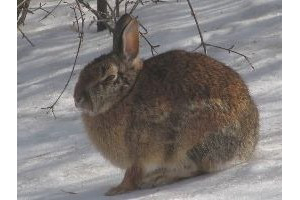Female eastern cottontails can truly reproduce like rabbits: they can have as many as seven litters of up to 12 young per year. While many young die before maturing, good habitat can quickly be overrun with rabbits if predators are not present.
Photo Credit: Gordon E. Robertson
Sylvilagus floridanus
Common Name: eastern cottontail
Other Common Names: varying hare
Animal Guild: Mammal
Class > Order > Family: Mammalia > Lagomorpha > Leporidae
What does the species look like?
Eastern cottontails are familiar rabbits with white stubby tails. Over their large range, they vary in both length , 395-477 mm (15-20 in), and weight, 0.8-1.5 kg (1.75-3.3 lbs). The coat is gray-brown to gray-black with a rufous patch on the nape of the neck. The range overlaps with several other species of cottontails and jackrabbits. Most of these species can be separated in the field, but familiarity with local species is important. The eastern cottontail is nearly indistinguishable from the New England cottontail (except by skull characteristics or genetic testing). It can be very difficult to distinguish between desert cottontails and eastern cottontails in the field where their ranges overlap (e.g., in eastern Colorado).
Where is the species found?
States & Provinces
AL, AR, AZ, BC, CO, CT, DC, DE, FL, GA, IA, IL, IN, KS, KY, LA, MA, MB, MD, MI, MN, MO, MS, MT, NC, ND, NE, NH, NJ, NM, NY, OH, OK, ON, OR, PA, QC, RI, SC, SD, SK, TN, TX, VA, VT, WA, WI, WV, WY
Distribution
The range extends from southeastern Canada through the eastern U.S. and Central America to northern Columbia and Venezuela. Eastern cottontails have been introduced and are well established in many areas outside the native range.
The eastern cottontail uses a wide range of habitats from woodland and forest to desert and prairie. They have adapted well to humans, moving into abandoned and active crop land, suburbs, and open lots in urban areas.
General Phenology and Life History
Reproduction starts as early as February in southern areas and May in the north. The timing of first breeding may be synchronized throughout a population, but after that litters may appear at any time, depending on survival of previous litters. Young develop quickly and are weaned in about 3 weeks. Juveniles from early litters may become reproductively active by late summer.
Which phenophases should I observe?
Do you see/hear...?
Activity
Live individuals More...
For abundance, enter the number of individual animals observed in this phenophase.
Feeding For abundance, enter the number of individual animals observed in this phenophase.
Development
Young individuals For abundance, enter the number of individual animals observed in this phenophase.
Dead individuals For abundance, enter the number of individual animals observed in this phenophase.
What do these phenophases look like?
There is currently no photoguide available for this species. If you'd like help us create one, use the guidance document and species template provided here . Then send it via email to education@usanpn.org when it is complete.
